Connecting with Checkout.com
Checkout.com helps your business offer more payment methods and currencies to more customers. They support 150+ currencies and have direct access to Visa, Mastercard, American Express, all major international cards, as well as popular local payment methods.
Checkout.com's Interchange++ model is more cost-effective and transparent than blended pricing. Additionally, the payment gateway supports features, such as stored credit cards and 3D Secure, to provide your customers with a convenient and secure checkout experience.
Checkout.com’s legacy ABC platform can no longer be used to accept payments. If you haven’t upgraded to the NAS platform, follow the instructions in this article to continue using Checkout.com.
Requirements
- Your store must be using Optimized One-Page Checkout.
- Your store must be based in one of the following countries:
| Argentina Australia Austria Bahrain Belgium Brazil Bulgaria Chile Colombia Croatia Cyprus Czech Republic Denmark Ecuador Egypt Estonia Finland France Germany Gibraltar | Greece Guernsey Hong Kong Hungary Iceland Ireland Isle of Man Italy Japan Jersey Jordan Kuwait Latvia Liechtenstein Lithuania Luxembourg Malta Netherlands New Zealand Norway | Oman Pakistan Peru Poland Portugal Qatar Romania Saudi Arabia Singapore Slovakia Slovenia Spain Sweden Switzerland UAE United Kingdom United States Uruguay |
- Manage Payments and Manage Settings user permissions must be enabled.
Setting up Checkout.com
To set up Checkout.com, go to Settings › Payments and select Checkout.com from the list of Online Payment Methods.

You'll be taken to the Checkout.com Settings tab. In the fields below, enter the credentials from your Checkout.com account into their corresponding fields. Click Save when done.
- Display Name — Control how the payment gateway appears at checkout. We recommend something like Credit/Debit.
- API Private Key — The API Private Key provided by Checkout.com when you created your account.
- API Public Key — The API Public Key provided by Checkout.com when you created your account.
- Transaction Type — Select Authorize and capture (recommended) or Authorize only. See Manually Capturing Transactions for details.
- Test Mode — Determines whether your store is in Test Mode. Set to No (recommended) when you are ready to take payments.
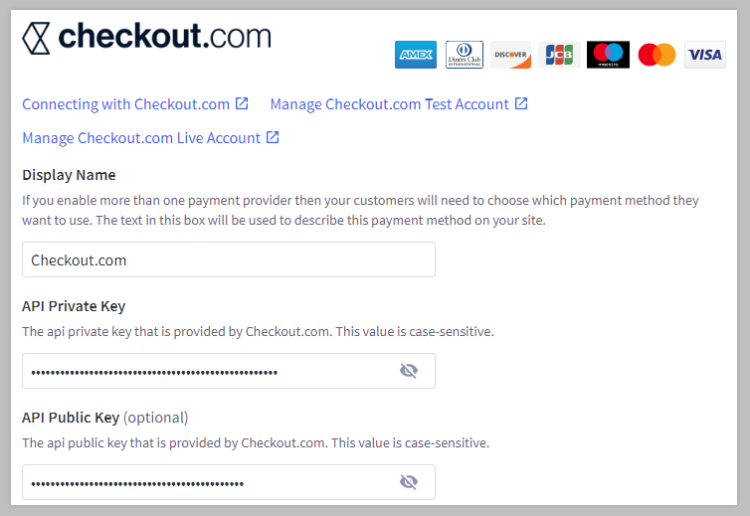
3D Secure
To enable 3D Secure fraud protection with Checkout.com, check the box next to Enable 3D Secure.

Stored Credit Cards
To enable Stored Credit Cards in your storefront, check the box next to Enable stored credit cards with Checkout.com.
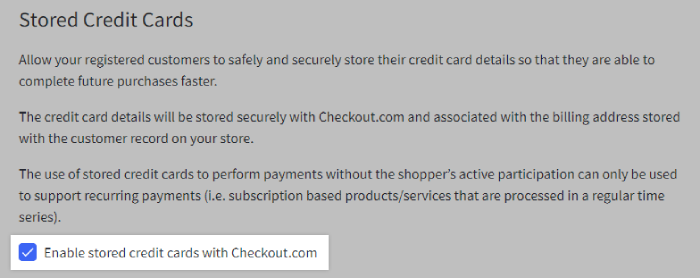
Displayed Cards
In the Select Displayed Cards field, you can manage which credit card brands appear next to the payment method at checkout. To hide a credit card brand on the checkout page, click the X to the right of the brand name, or click the dropdown arrow and uncheck the box next to the brand name.
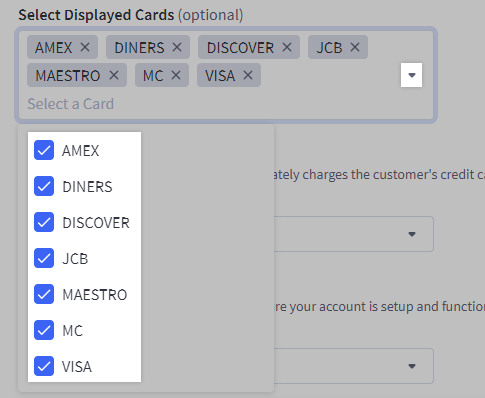
Notification URL
If you’re using the latest version of Checkout.com, the Notification URL field will appear in your Checkout.com Settings tab. This read-only field indicates that the payment status of Checkout.com orders are automatically communicated between your BigCommerce control panel and Checkout.com account.
No action is required to configure notifications.

Advanced Fraud Prevention
By using Checkout.com, you can access a wide range of cutting-edge fraud prevention tools, including custom-built rules, disputes management, and tokenization.
In addition, the integration supports the ability for merchants to manually review transactions that Checkout.com has flagged as “risky”. Risk flagging is enabled through the Checkout.com dashboard. After configuring risk rules in your merchant account, Checkout.com will automatically flag any transactions where a rule's conditions are triggered.
The flag status is used to alert you to any suspicious transactions on your Checkout.com account. Not every flagged transaction may be fraudulent, but flags indicate that a transaction is worth investigating.
When a payment is flagged, you must either capture or void it manually. If you take no action, the payment expires automatically after seven days, and the funds return to the customer. Transactions can be captured or voided from your Checkout.com dashboard or from the BigCommerce control panel. Regardless of where you perform the void or capture, the transaction's payment status will be updated to reflect its new status in both Checkout.com and BigCommerce.
To enable advanced fraud protection on your Checkout.com account, contact Checkout.com support, then follow the process listed in the Checkout.com support article on fraud detection to configure your risk rules.
Once advanced fraud protection has been set up, orders using Checkout.com will use one of the following three payment statuses in the BigCommerce control panel:
- Approved — The transaction was automatically approved by Checkout.com. Approved new orders will use the "Awaiting Payment" or "Awaiting Fulfillment" order status in BigCommerce.
- Flagged (manual verification) — The transaction was automatically flagged by Checkout.com for manual verification. Flagged orders will use the "Manual Verification Required" order status in BigCommerce.
- Rejected — The transaction was automatically rejected by Checkout.com as suspicious. Rejected orders will show in BigCommerce under the Incomplete tab, using the "Pending" order status and "Declined" payment status.
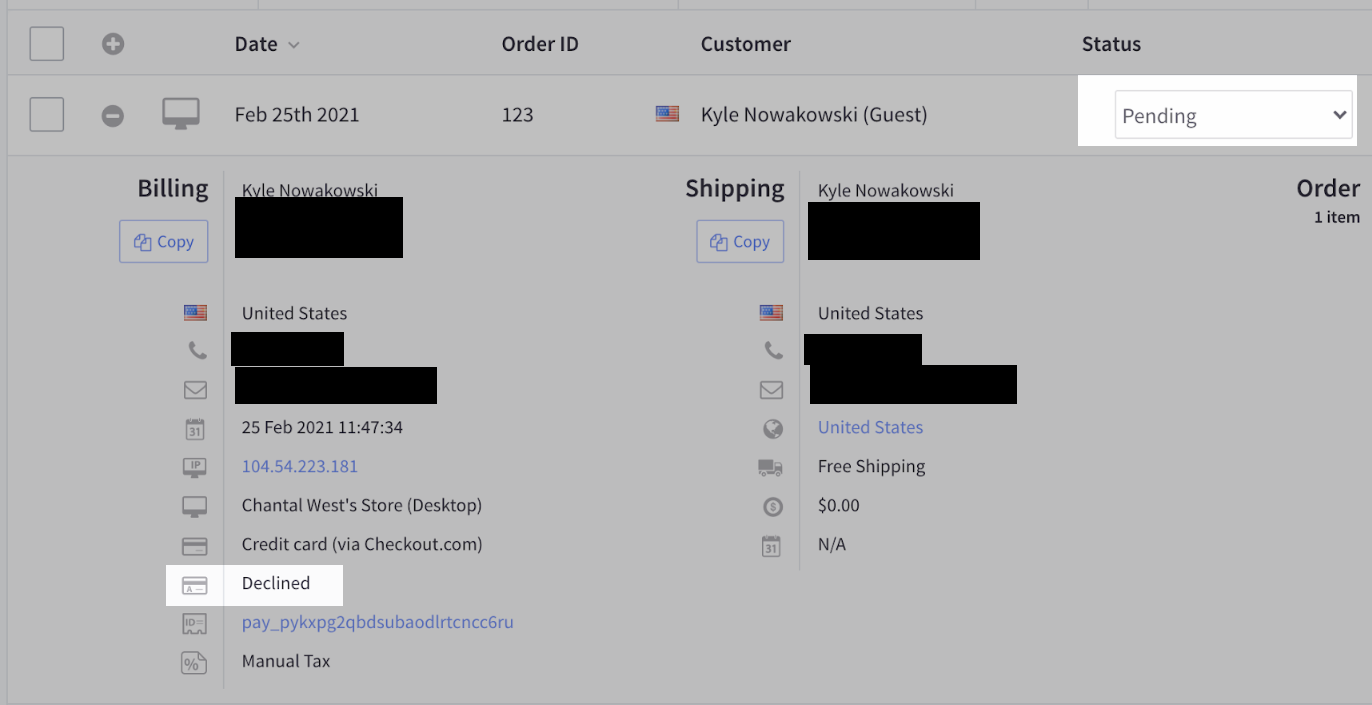
Upgrading to the Latest Version of Checkout.com
The latest version of Checkout.com, also known as the NAS platform, enables automatic notifications between Checkout.com and BigCommerce. If you are connecting to Checkout.com for the first time, then you are already using the NAS platform.
If you are using the previous version of Checkout.com, also known as the ABC platform, follow the steps below in your BigCommerce control panel and Checkout.com account to upgrade to the NAS platform.
After completing the upgrade steps, do not revert to the ABC platform. Your Checkout.com payment methods will not appear at checkout if your Account Type is set to ABC Account.
BigCommerce Control Panel
Start upgrading Checkout.com in your control panel by updating your connection credentials. This will also allow you to perform refunds on orders placed prior to upgrading.
1. Navigate to Settings › Payments and click the Checkout.com Settings tab.
2. In the Account Type dropdown, select NAS Account.

3. Update your API Public Key and API Private Key with the Public Key and Secret Key respectively. These are located in the Developers › Keys area of your Checkout.com dashboard.
4. 4. Check the box next to Enable refunds for ABC orders, then add the ABC API Private Key and ABC API Public Key in their corresponding fields. You can find these credentials in the Settings › Channels area of your Checkout.com Hub (not the Checkout.com dashboard). Save your changes when done.
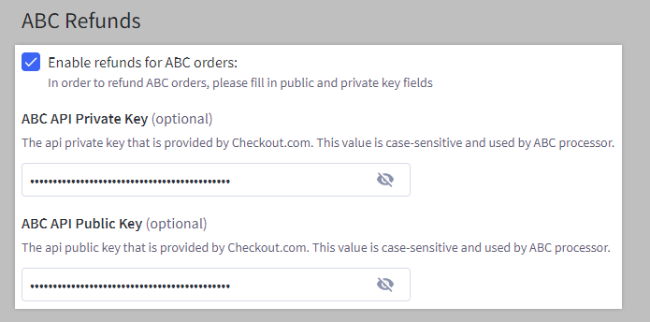
Checkout.com Account
Follow these steps in your merchant account to complete the upgrade process.
1. Go to Developers › Keys in your Checkout.com merchant account and select your Secret Key. This is the same API Private Key used to connect Checkout.com in the BigCommerce control panel.
2. In the Key Details page, click Update Key.

3. Scroll down to Processing Channels and toggle off Allow any processing channel. Check the box next to your BigCommerce channel and click Save changes when done.
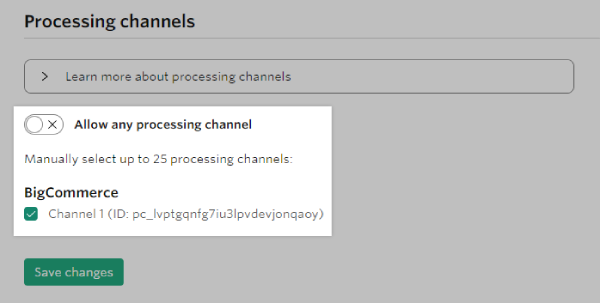
Repeat these steps with your Public Key to finish upgrading to the latest version of Checkout.com.
Common Questions
- General
- Pricing and fees
- Account eligibility
- Transactions
- Refunds
- Additional features
- Troubleshooting and payment disputes
This information is for the Checkout.com integration. For common questions and troubleshooting information about a supported APM, see our Guide to Alternative Payment Methods.
General
Which credit cards are supported by Checkout.com?
Checkout.com supports the following card brands:
- Visa
- Mastercard
- AMEX
- Diners Club
- Discover
- Maestro
- JCB
Pricing and Fees
What fees are associated with the gateway?
Checkout.com uses Interchange++, which offers more transparency than other pricing models. With Checkout.com there are minimum monthly fees, no contracts required, and pricing is based on your transaction volume and history.
Other payment processors charge a blended rate. We use the Interchange++ model, a payment processing fee structure that standardizes the commissions collected by card issuers such as Visa and Mastercard. The amount varies based on card type, the customer's issuing bank, merchant location, and other parameters.
Using Interchange++, we pass the fees charged by card brands directly through to you. Checkout.com charges a single, consistent mark-up that never changes, so you’ll have full transparency of your costs and know exactly what you’re paying. There are also no hidden fees, no setup fees and no account maintenance fees. Additionally, you’ll also get:
- Dedicated account management and service
- Risk and fraud management tools
- Integration with all major shopping carts
To learn more about pricing, see Checkout.com's pricing page.
Account Eligibility
What currencies and countries does the payment gateway support?
See Requirements for the list of supported countries.
150+ transaction currencies are supported in the integration.
What items are restricted for merchants to sell?
Checkout.com publishes information on the lines of businesses they cannot support under their terms and policies.
Transactions
After I create an account, what is the waiting period before I can process transactions?
A test account can process Google Pay and Apple Pay transactions immediately after account creation. Other transactions such as card payments and alternative payment methods need to be activated onto the merchant's account, which can be done by contacting the Checkout.com support team. It can take up to one day to activate these payment methods, and once that is complete, transactions can be processed. Merchants processing payments in UAE and Saudi Arabia are also required to contact their Customer Success Manager at Checkout.com to activate Google Pay and Apple Pay.
For live transactions, the merchants are required to contact their Customer Success Manager to process live transactions. This onboarding process can take up to a week as legal, pricing, and settings need to be arranged and configured between the merchant and Checkout.com.
How long until the funds are transferred to my bank?
Three days is standard. Reach out to your Checkout.com representative for more information.
Will I or my customers receive an additional email or invoice from the payment gateway?
No, invoice emails are sent out by BigCommerce.
Do I need to enable anything with Checkout.com?
Yes, merchants will need to enable Checkout’s full card API to integrate with BigCommerce and process card payments. Contact the Checkout.com support team to enable this feature on your account.
Can I edit the order and capture a different amount?
Yes, you can edit the order and capture a different amount, also known as “partial capture”. However, in order to capture a different amount, the edited order amount must be less than what was originally authorized. Edit the order (Edit Order under the Order View) and set the amount to the desired capture amount. After editing, select Capture Funds to complete the partial capture with Checkout.com. The remaining authorized amount will be automatically voided at this stage.
Partial captures performed outside of BigCommerce (via the Checkout.com Hub/API) will not be reflected in the Order View. If you have partially captured an order outside of BigCommerce, you will need to locate the order in BigCommerce and edit the value to match the captured amount.
Are funds captured on the same day?
No, funds are not captured on the same day for orders using Sofort, EPS, Bancontact, Multibanco, and Przelewy24.
If you are using the legacy version of Checkout.com, funds are not captured on the same day for orders using SEPA Direct Debit and Boleto Bancário as well.
Refunds
How soon after a transaction can I perform a refund?
You can refund a payment anytime after it has been captured from your BigCommerce dashboard.
Is there an amount of time after which I cannot perform a refund?
The only constraint is from Amex, which is 365 days. Otherwise, there is no time limitation for refunding captured payments.
In the example above, you would see "EGP 109.99" displayed on the order in your store, but you would see "EGP 109.00" (the actual refunded amount) in your Checkout.com account.
Are there any fees for chargebacks/refunds?
Yes, there are fees for chargebacks. The issuer creates a formal dispute which immediately reverses the payment, debiting your account for both the payment amount and a dispute fee (for example, £15 for merchants in the United Kingdom). Since chargeback fees vary, based on region and merchant contract, please contact your sales manager at Checkout.com for further details.
Are external refunds outside the BigCommerce dashboard supported?
No. External refunds are not supported in the integration. Meaning, if you refund the transaction from within your Checkout.com dashboard, it will not be synced with the order in your BigCommerce control panel. You will need to manually update the order in BigCommerce in this case.
However, refunds from within your BigCommerce control panel are supported.
Additional Features
Are there any fraud filtering options available?
Checkout.com’s risk engine includes fraud detection and prevention settings through the creation and use of risk rules, which can be configured from the Checkout.com Hub. See Advanced Fraud Prevention for more information.
Are authorize-only or recurring/subscription payments allowed?
Checkout.com supports authorize-only payments that you can capture manually at a later time. However, recurring/subscription are not currently available.
Is multi-currency supported?
Yes, multi-currency is supported with Checkout.com. See Managing Currencies for more information.
Are alternative payment methods (APMs) available with Checkout.com?
Yes, to enable a payment method on your store, contact your Checkout.com Customer Success Manager or reach out to Checkout.com Support to activate it on your Checkout.com account. Once enabled, go to Settings › Payments in the BigCommerce control panel and click on the Checkout.com Settings tab. Enable the payment method, then save your changes.
The following APMs are available via Checkout.com. Click on an APM to see its requirements and limitations.
* Mada card payments are not supported by the latest version of Checkout.com; however, customers can select a Mada card to pay for orders while using Checkout.com’s Apple Pay integration.
Troubleshooting and Payment Disputes
Why did my shopper receive an error when trying to pay?
Check the transaction in the Checkout.com Hub for further information. You can find a list of payment errors defined in Checkout.com’s article on Error codes. Contact Checkout.com's support team if you require further assistance.
How are payment disputes handled?
Disputes (also called Chargebacks) occur when a buyer contacts their issuing bank (the company who gave them their card), claiming that a payment they found on their statement is not valid or not made by them, and as a consequence, they would like their money back. This diagram outlines the process in Checkout.com.
In most cases, the issuing bank (also called the issuer; the institution/bank that gave the card to the customer) issues this payment to be charged back to their account via the card scheme that was used. When this happens, Checkout.com accounts are debited by the card network, and then Checkout.com debits the merchant.
Step 1: Payment charged back
A dispute results in a debit to your account, unless that payment has already been refunded (in which case Checkout.com resolves it for you) or the issuer reverses the dispute (in which case you'll be repaid the disputed amount).
Step 2: Submit evidence
If you wish to argue your case, you will need to submit evidence to Checkout.com, so they can pass it along to the card scheme. It's best to respond to a dispute as soon as possible.
Step 3: Await the outcome
Once you've submitted your evidence, you'll have to wait up to 55 days for the issuing bank to make a decision.
- Outcome A
If they accept your evidence, you will be credited back the disputed amount. Congratulations, you've won the dispute! - Outcome B
If they reject your evidence, you have lost the dispute. There are no further financial implications.
How do I contact Checkout.com's support team?
Checkout.com's support team can be reached via email.
 © Copyright 2003 - 2024 BigCommerce Pty. Ltd. Shopping Cart Software
© Copyright 2003 - 2024 BigCommerce Pty. Ltd. Shopping Cart Software